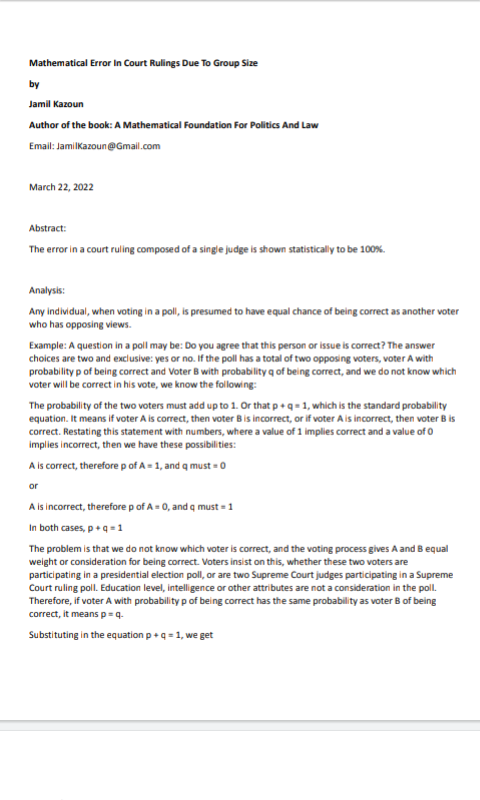Mathematical Error In Court Rulings Due To Group Size

Mathematical Error In Court Rulings Due To Group Size
by Jamil Kazoun
Author of the book: A Mathematical Foundation For Politics And Law
Email: JamilKazoun@Gmail.com
March 22, 2022
Abstract:
The error in a court ruling composed of a single judge is shown statistically to be 100 percent.
Analysis:
Any individual, when voting in a poll, is presumed to have equal chance of being correct as another voter who has opposing views.
Example: A question in a poll may be: Do you agree that this person or issue is correct? The answer choices are two and exclusive: yes or no. If the poll has a total of two opposing voters, voter A with probability p of being correct and Voter B with probability q of being correct, and we do not know which voter will be correct in his vote, we know the following:
The probability of the two voters must add up to 1. Or that p + q = 1, which is the standard probability equation. It means if voter A is correct, then voter B is incorrect, or if voter A is incorrect, then voter B is correct. Restating this statement with numbers, where a value of 1 implies correct and a value of 0 implies incorrect, then we have these possibilities:
A is correct, therefore p of A = 1, and q must = 0
or
A is incorrect, therefore p of A = 0, and q must = 1
In both cases, p + q = 1
The problem is that we do not know which voter is correct, and the voting process gives A and B equal weight or consideration for being correct. Voters insist on this, whether these two voters are participating in a presidential election poll, or are two Supreme Court judges participating in a Supreme Court ruling poll. Education level, intelligence or other attributes are not a consideration in the poll. Therefore, if voter A with probability p of being correct has the same probability as voter B of being correct, it means p = q.
Substituting in the equation p + q = 1, we get
p + p = 1
or
2p = 1
which means
p = ½ = 0.5
Since p = q
q = 0.5
Conclusion 1: Voters A and B, are presumed to have an equal probability of being correct, and this probability is discovered to be p = 0.5. This is an extremely consequential result as we will see next.
Statistically, the mean of an experiment or a poll can be thought of as an average. Example: If we have three men, with weights 100 kg, 105 kg and 95 kg, we can compute the average weight of this group to be 100kg.
The error in a sample mean is determined by the Central Limit Theorem which states that the statistical error of an estimated mean is: Standard Deviation divided by square root of the sample size or group total number n:
SE = SD / sqrt(n)
SE stands for the Standard Error Of The Mean
SD stands for the Standard Deviation. SD = sqrt(p x q)
n stands for the sample size
If the sample size is composed of a single voter in the poll, then n = 1. We know that before voting, p = q = 0.5. Now we can compute the error in the poll that is dependent on sample size, and is independent of poll results:
SE = sqrt(p x q) / sqrt(n) = sqrt(0.5 x 0.5) / sqrt(1) = 0.5 or 50 percent error.
Therefore the Standard Error is 50 percent. Since this error is a radius centered around the mean, the total error is 2 x SE, and the SE total error is 100 percent.
Therefore, a single judge ruling has a statiscal error of 100 percent.
After a poll is conducted, a second error gets involved and needs to be computed, and it is related to the mean of Poll Results. We will not add this error here, as we are focused only on the error from voters size, and not what their vote is.
Note: A more stringent error formula used to compute error of the mean is the Margin Of Error or MOE. It is the same as SE but adds one more variable to the equation. MOE = Z x SE. Z is related to Confidence Level in computation results. We will not consider this condition here, since the error will be even greater using MOE, and is sufficient to illustrate the problem.
In statistics, it is established that a larger sample size, all things being equal, translates to greater confidence in the correctness of a computed mean. But the general public may not know this, but still may "feel" it correct. Therefore, without a mathematical basis, a Supreme Court may insist on 9 voters (jury of judges) for a decision, while a court jury in a death verdict may insist on a group size of 16 jurors (voters) for a decision, while the public may insist on a group size of millions of voters for a decision on a presidential candidate.
Conclusion 2: A ruling by a single judge should not be allowed, as statistically highly error proned. And to reduce error, a sufficiently large group voting is required for such decisions.
Summary: A single-judge ruling has statistically 100 percent error. This means such judicial systems are fundamentally flawed and require immediate halt to all judicial cases, pending a review and a resolution of this issue.
